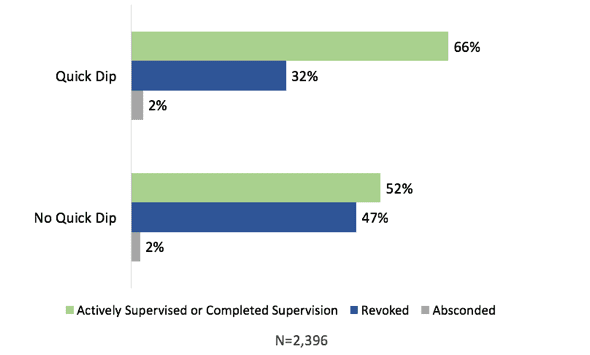 Repeated probation violations and few tools to respond caused probation officers in North Carolina to revoke so many people from probation that they accounted for more than half of the state’s prison admissions in FY2009. Three-quarters of those people were revoked for technical violations, such as missing a curfew or failing a drug test. Now, probation officers are able to use a range of strategies to promote success on probation, including risk and needs assessments, case planning, and structured intervention worksheets, and depending on the number and seriousness of the violations, probation officers may choose from a continuum of sanctions, including a two- to three-day “quick dip” sanction to jail shortly after a probation violation.
Repeated probation violations and few tools to respond caused probation officers in North Carolina to revoke so many people from probation that they accounted for more than half of the state’s prison admissions in FY2009. Three-quarters of those people were revoked for technical violations, such as missing a curfew or failing a drug test. Now, probation officers are able to use a range of strategies to promote success on probation, including risk and needs assessments, case planning, and structured intervention worksheets, and depending on the number and seriousness of the violations, probation officers may choose from a continuum of sanctions, including a two- to three-day “quick dip” sanction to jail shortly after a probation violation.
Establishing quick dips
North Carolina established the use of quick dips in statute as part of a series of improvements to probation through its Justice Reinvestment Act (JRA) of 2011. Quick dips are imposed shortly after a violation occurs and are intended to serve as a wake-up call for people engaging in noncompliant behavior on supervision, prompting them to comply with the conditions of their supervision before they face more serious consequences for violations. States across the country are increasingly using this type of sanction to respond to lesser violations and those that lead to revocation.
Putting these sanctions into practice in North Carolina required developing policies to determine who could receive a quick dip and for which behaviors, training probation officers extensively, and updating data systems to track how probationers who received a quick dip fared in comparison to those who did not. Recognizing the potential impact of quick dips on county jail populations, the Department of Public Safety (DPS) worked with jail administrators to ensure that they had available space to house probationers receiving quick dips. When jails lacked space, DPS helped probation officers identify alternatives, such as periods of home confinement with electronic monitoring. The agency worked with judges to address concerns about delegating authority to probation officers to use quick dips and partnered with the University of North Carolina School of Government to write a book and reference card for criminal justice stakeholders about the provisions within the JRA, including identifying potential challenges related to imposing quick dips and explaining why the policy changed.
Analyzing the early impact of quick dips
DPS began using quick dips in 2012. Early data from the state suggests that their utilization of quick dips is proving to be effective. In a 2016 study, DPS compared outcomes for 1,198 people who had a quick dip between FY2013 and FY2015 in response to a violation with 1,198 people who did not have a quick dip as a response to a similar violation.[1] The analysis revealed that people who received a quick dip were about one-third less likely to be revoked to prison than the comparison group (32 percent compared with 47 percent, respectively), and people who received a quick dip were more likely to be actively supervised or successfully complete supervision one year after a quick dip than the comparison group (66 percent compared with 52 percent, respectively). [See Figure 1] The study also found that the average time between the violation date and when a sanction was imposed for people who received a quick dip was 5 days compared with 86 days for people who did not receive a quick dip.
Figure 1. One-Year Outcomes for People Who Received a Quick Dip and Matched People Who Did Not, FY2013–FY2015
“This study is just the beginning,” said George Pettigrew, DPS Justice Reinvestment Administrator. “We’re partnering with independent researchers to conduct further evaluations on the impact of quick dips and other supervision practices, including using incentives and structured intervention worksheets to promote success on supervision. DPS is committed to using data to drive policy, and this next evaluation will help us continue to improve supervision practices and reduce revocations.”
________________________________________________________________________________
[1] These groups were matched using controls for demographics, criminal history, risk level, and type of violation. Supervision outcomes were compared starting 12 months after the sanction continuing through June 30, 2015.
This project was supported by Grant No. 2010-RR-BX-K071 awarded by the Bureau of Justice Assistance. The Bureau of Justice Assistance is a component of the Department of Justice’s Office of Justice Programs, which also includes the Bureau of Justice Statistics, the National Institute of Justice, the Office of Juvenile Justice and Delinquency Prevention, the Office for Victims of Crime, and the SMART Office. Points of view or opinions in this document are those of the author and do not necessarily represent the official position or policies of the U.S. Department of Justice.
Arkansas policymakers have long expressed concerns about the state’s high recidivism rate. Over the past 10 years, an…
Read MoreIn April 2025, Arkansas Governor Sarah Huckabee Sanders signed a package of bipartisan criminal justice legislation into law,…
Read More Explainer: Key Findings and Options from Arkansas’s Justice Reinvestment Initiative
Explainer: Key Findings and Options from Arkansas’s Justice Reinvestment Initiative
Arkansas policymakers have long expressed concerns about the state’s high recidivism rate.…
Read More Explainer: How a New Law in Arkansas Tackles Crime, Recidivism, and Community Supervision Challenges
Explainer: How a New Law in Arkansas Tackles Crime, Recidivism, and Community Supervision Challenges
In April 2025, Arkansas Governor Sarah Huckabee Sanders signed a package of…
Read More










